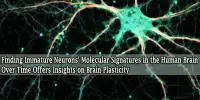The full set of ten parameters, including the sequence in which these neurons mature, that control the different types of brain cells in the visual system of fruit flies have been discovered by researchers.
The results, which were published in Nature, offer up new lines of inquiry into how animal brain evolution and regenerative medicine have interacted.
The human brain is composed of 80 billion neurons. The structure, function, and connection of these nerve cells with other neurons to form brain networks vary. The brain’s complexity enables it to carry out a wide range of tasks, including managing speech and vision as well as creating emotions and storing memories.
Although there are many different types of neurons, developmental neurobiology and regenerative medicine are concerned with how this diversity emerges during the development of the brain.
“Knowing how the human brain develops could allow us in the future to repeat these developmental processes in the lab to generate specific types of neurons in a Petri dish and potentially transplant them in patients or to trigger neuronal stem cells in living organisms to generate and replace missing neurons,” said Claude Desplan, Silver Professor of Biology at NYU and the study’s senior author.
Researchers utilize model species like mice and flies to investigate the numerous mechanisms involved in the brain’s operations because understanding the human brain is a tremendously complex task.
Different types of neurons are generated sequentially as the brain develops in both vertebrates, such as mice and humans, and invertebrates, such as flies. Specific types of neurons are generated first, and other types are generated later from the same progenitor stem cell.
Impairment of the temporal cascade progression leads to the generation of reduced neuronal diversity, hence altering brain development.
Isabel Holguera
Temporal patterning is the process through which neural stem cells develop various types of neurons across time. Neural stem cells generate a variety of neurons by secreting various molecules called temporal transcription factors, or tTFs, which control the expression of particular genes in each time window.
The full set of tTFs required to produce the about 120 different neuron types of the medulla, a particular brain region in the visual system of flies, were discovered by the researchers in the study that was published in Nature by studying the brains of the fruit fly Drosophila. They obtained the transcriptome of all the genes expressed in each of the more than 50,000 individual cells, which were subsequently categorized into the majority of cell types seen in the developing medulla, using cutting-edge single-cell mRNA sequencing.
By concentrating on neural stem cells, the researchers were able to identify the entire set of tTFs that characterize the various temporal windows in this brain region as well as the genetic network that regulates the expression of these various tTFs, which permits this temporal cascade to proceed.
“Several tTFs had been previously identified in the brain’s visual system using available antibodies; we have now identified the comprehensive series of 10 tTFs that can specify all the neuron types in this brain region,” said one of the study’s lead authors, Nikolaos Konstantinides, now a group leader at the Institut Jacques Monod in Paris and a former postdoctoral fellow in the Desplan lab.
The genetic relationships that enable the temporal cascade to advance were later discovered by the researchers, along with how this progression links to the “birth order” of all neurons in the medulla, associating particular temporal windows with the development of particular types of neurons. This cascade is required to develop this brain region’s entire range of neuronal variety in a stereotypical order.
“Impairment of the temporal cascade progression leads to the generation of reduced neuronal diversity, hence altering brain development,” said Isabel Holguera, a postdoctoral fellow in NYU’s Department of Biology and one of the study’s co-first authors.
Last but not least, the team looked at the early stages of differentiation, the process by which neural stem cells develop into neurons. They discovered striking similarities between the differentiation processes of human cortical neurons and fly neurons, including patterns of gene expression during each stage of differentiation.
“Our findings suggest that understanding the mechanisms of neuron development in flies can generate insight for the equivalent process in humans,” said co-first author Anthony Rossi, now a postdoctoral fellow at Harvard and a former graduate student in the Desplan lab.















